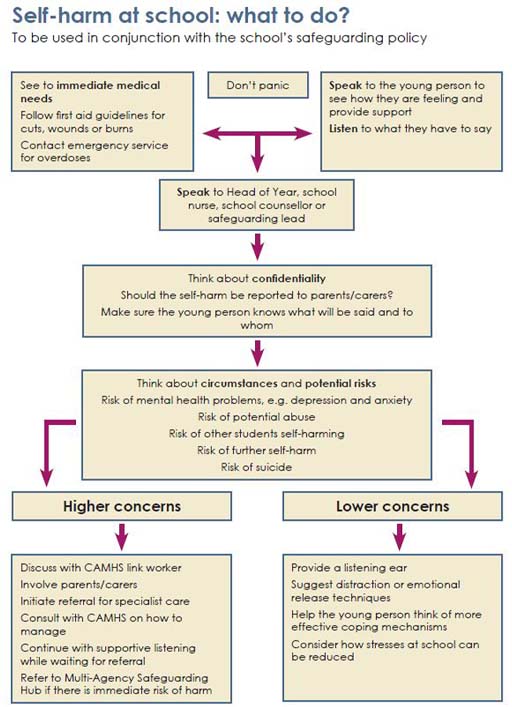1.1 Mental health at school
The flow chart in Activity 2 has been developed by researchers at the University of Oxford (Charlie Waller Memorial Trust, 2018). It is aimed at school staff, so if you are a parent or carer you may want to approach this activity in the spirit of understanding the practices underpinning disclosure of self-harm. The essence of this response process can also be applied to other mental health concerns.
Activity 2: Developing a response to mental health concerns at school
Spend a few minutes reading through the process and if you are based in a school, consider whether there are any ways you could develop your knowledge and skills at work.
Consider which of the actions in this chart could apply to you as a parent or in your professional role where relevant. Are there any gaps in your knowledge and skills for taking these actions? Make notes below on ways in which you think you are prepared or could prepare yourself to handle a self-harm situation.
| Actions | Self-development possibilities |
|---|---|
| See to immediate medical needs | |
| Speak to the young person and listen to what they have to say | |
| Speak to the head of year, school nurse, school counsellor or safeguarding lead | |
| Think about confidentiality | |
| Think about circumstances and potential risks | |
| Address ‘lower concerns’ | |
| Address ‘higher concerns’ |
Discussion
In dealing with the physical injuries, you may need to seek help from a trained professional, or if you are acting as an educator you should be able refer to a first aider in your workplace.
Speaking to the young person, it will be important to draw on some active listening skills. Remember that you worked on these in Session 6 [Tip: hold Ctrl and click a link to open it in a new tab. (Hide tip)] .
It may be necessary to urgently identify other professionals you could make contact with.
Confidentiality is clearly important to many young people but it is important to know that for educators, your school will have policies about how you should handle sensitive information and were responsibilities lie in regard to safeguarding.
The circumstances and potential risks can be wide ranging, and these serious judgements need to be made in discussion with others.
While a flow chart is useful in providing a clear checklist of the actions that might be useful when a young person reveals they have been self-harming or displaying other behaviours of concern, it can be hard in the moment to know how to respond as one human to another. You will consider this in the next activity.

